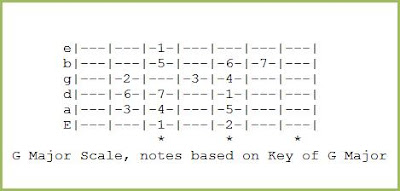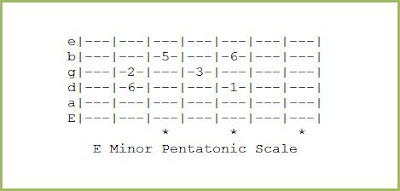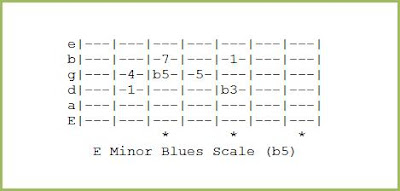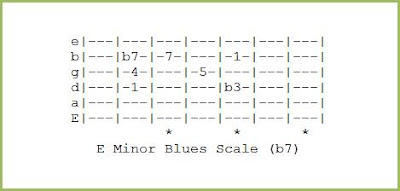The E Minor (Em) Blues Scale (b5) for guitar is an example of a minor scale derived from its root scale, the G Major Blues Scale. Basically, the G Major blues scale (b5) is a G Major pentatonic scale with an added flattened fifth (b5) or, in the case of the Key of G Major, the C# note.
Here is the G Major Scale from where the G Major Pentatonic Scale and G Major Blues Scale are derived from:
The "E" note in the G Major Scale or in the Key of G Major is number "6". In order to derive the relative E Minor Scale from the G Major Scale given, we should begin with the "E" or "6th" note. Thus, we get the the following scale, which is the E Minor Scale, beginning from the 6th note and ending in the same 6th note:
To make the E Minor Scale into an E Minor Pentatonic Scale, simply remove the "4th" and "7th" notes. The resulting scale should now look like this:
To make the E Minor Pentatonic Scale into an E Minor Blues Scale, first substitute the numbers in your previous scale starting with 6 now as 1, 1 now as b3 (flattened third), 2 now as 4, 3 now as 5, and 5 now as 7. It should now look like this:
Lastly, to make your E Minor Pentatonic Scale into an E Minor Blues Scale, simply add a flattened fifth note (b5) to the E Minor Pentatonic Scale.
Or you may want to try E Minor Blues with a flattened 7th note (b7). Simply add a flattened seventh note (b7) to the E Minor Pentatonic Scale, which should look like this on your guitar fretboard:
Here's the E Minor Blues Scale with a flattened fifth (b5) on the higher frets of your guitar fretboard:
<<--RETURN TO LESSON 6: NAMING AND NUMBERING NOTES